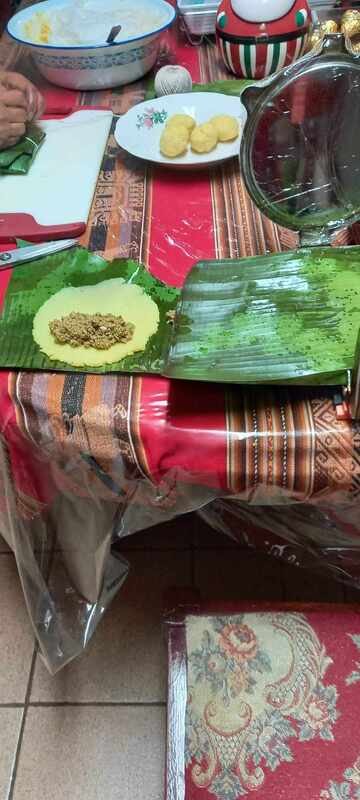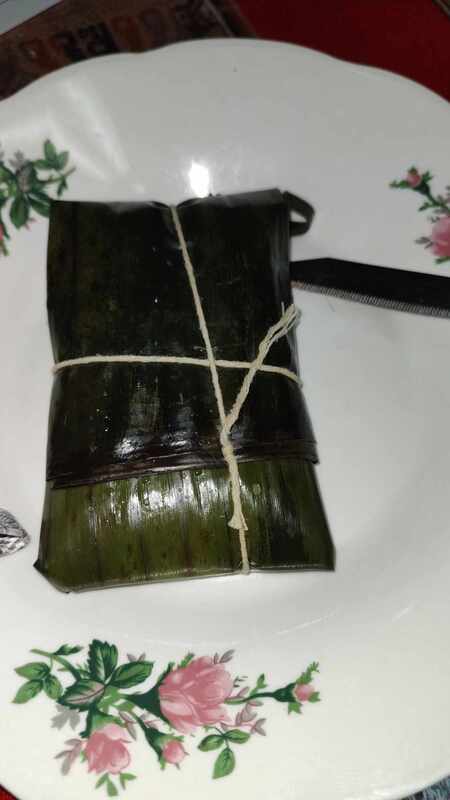|
Author :Angelo Bissessarsingh
Christmas just ain't Christmas without a good ham. In Trinidad of yesteryear, the precious leg of pork would be boiling in a pitch-oil tin for many hours before being baked, either in a coalpot tin oven or a beehive mud oven, to be served with other traditional fare like pastelles and fruit cake. Chances are the ham would be diminished long before the family could have a go at it, through the inroads of "moppers," otherwise known as village paranderos. The choices for ham lovers were not easy. Price was a major consideration as well as quality. In the countryside areas, the ham everyone knew was a salty, well-cured leg of pork hanging from the rafters of the Chinese shop. This would be an American ham, imported in barrels of sawdust with some of that still clinging to the surface. After boiling the skin would be stripped off before baking. The skin itself was kept until after Christmas, when money was scarce, and would be used to provide protein in a meal of rice or as the meat in a sandwich. It could also be fried crisp and eaten as a snack. The fat was used to leaven bakes. Even the ham bone did not go to waste. Broken up in pieces, it was used in soups, callaloo and oil-down. The lowest grade of ham was what was known as the "pitch ham." This was locally made and smoked. To preserve it, the pitch ham had a coating of asphalt on the outside, which made the skin inedible and imparted a mineral flavour to the meat which I am told was far from unpleasant-although one can imagine that it was not the healthiest food around. In the early 20th century, an American ham cost about $5, with the pitch ham selling for $2 less. This was no mean expenditure in an era when it was a decent monthly wage for a domestic servant, making the ham an indulgence. The ham most Trinis were familiar with was the York ham. The York ham is mildly flavoured, lightly smoked and dry-cured, which is saltier but milder in flavour than other European dry-cured ham. It has delicate pink meat and does not need further cooking before eating. It is traditionally served with Madeira sauce. Folklore has it that the oak used for construction for York Minster in England provided the fuel for smoking the meat. York hams were sold from most city groceries like Cannings and the Ice House and also department stores with provision departments, like Stephens. The famous Ice House Grocery on Marine (Independence) Square included a York ham in its famous $5 Christmas hampers. Packed chock-full of goodies like Muscatel wine, nuts, imported sweets and dried fruits for the famous rum cake, these hampers could be packed into a wooden box and forwarded by rail to customers deep in the countryside. Even though some prefer turkey, the hallmark of Christmas is still a ham. Photo 1. : Salt ham hanging at Sing Chong Supermarket on Charlotte Street, Port of-Spain. Photo Credit : BRIAN NG FATT. (Source: Angelo Bissessarsingh's Virtual Museum of Trinidad & Tobago, Nov 27, 2023)
0 Comments
By HISTORIAN AND AUTHOR ANGELO BISSESSARSINGH (2010)
For most Trinidadians, no Christmas season would be complete without a trip to Frederick St in Port of Spain to take advantage of bargains, window-shop and to savour the whirl and rush of humanity occasioned by the hectic Christmas atmosphere. This photo dates from 1950. With the jolly season now in full swing, we begin to be aware of those annual occurrences which make Christmas in Trinidad a unique and savory experience. The hams have begun to put in appearances in the supermarket freezers, and the ruddy hue of sorrel on the wooden trestles of roadside hucksters. Demijohns of ginger ale have begun to grace windowsills for fermentation, and notwithstanding the astronomical price of the raw material, most assuredly will give a sharp bite to those who dare to partake of the aged vintage. Errant bakers of the domestic kitchens are sampling with gusto the rum-drenched dried fruit which have been soaking since the middle of June and which will soon form an integral part of an aromatic fruit cake. Toys which range from the simple trinkets of a bygone era to complex mechanisms with embedded microchips have commenced their temptation of young desires who fervently hope that Santa will bestow upon them, the rewards of a year of good behavior. Amidst the thick air of anticipation and festivity it would not be amiss to take a retrospective look at local Christmases of yesteryear. Almost every nostalgic Trinidadian and Tobagonian can tell stories of the ham being boiled in a pitch-oil tin, the flurry of new curtains, paranderos and the joyous tedium of pastelles on the make, but I intend to take a more historically systematic view when looking at the Trini Christmases Past. In the pre-emancipation era (1834 and earlier) Christmas was celebrated in the plantation great houses with much pomp and ceremony as befitted the status of landed gentry. With the influx of French settlers with the 1783 Cedula of Population, Christmas balls became fairly commonplace, graced no doubt by lavish dinners of wild meat roasts, consommés of local fruit, and wines imported from Europe. The house slaves of the estates would have been the grateful end beneficiaries of the residue of these Christmas revels of the masters. The pleasure of the field slaves were infinitely more simple and consisted of little more than an extra allowance of food and perhaps a length of cloth. One account from 1823 tells of a Christmas on Lopinot’s La Reconnaissance cocoa estate where slaves were given a dole. The account runs thus ‘At nine o’clock while at breakfast, the whole of the negroes came dressed in the gayest clothes to wish us a Merry Christmas, and a piece of beef and an allowance of flour and raisins were distributed to all of them with a proportion of rum for the men and wine for the women.’ The writer continues to describe how the slaves were given two suits of clothes each, following which they visited the cemetery of the Lopinot family (still to be seen) where prayers were said for the departed Comte de Lopinot and flowers strewn over the huge unmarked gravestones. With the advent of East Indian labourers on the sugar and (to a lesser extent) cocoa estates of the island after 1845, Christmas took on a dimension of minor importance. Mostly, the labourers were Hindus and Muslims and therefore did not celebrate Christmas. Admittedly, some aspects of the field slave Christmas still survived as 19th century accounts tell of one proprietor’s wife in Central Trinidad, Elisa DeVerteuil, sharing out an annual bonus of flour, cloth and other staples to the East Indians of Woodford Lodge estate. The arrival of Rev. John Morton in 1868 marked the commencement of the Canadian Mission to the Indians (CMI) through the auspices of the Canadian Presbyterian Church. Under the influence to the early missionaries of the CMI, Christmas became a more regular occurrence in the predominantly Indo-Trinidadian sugar-belt communities of Central and South Trinidad. Those early CMI Christmases were simple affairs, with carols being sung (some in Hindi through the translations of the Rev. Dr. Kenneth Grant and Lal Behari) and presents in the form of decorated cards and booklets being distributed, these being sent from mission fields in Canada for the benefit of their ‘heathen’ brethren in Trinidad. Conversely, as is recorded by Sir V.S Naipaul in A House for Mr. Biswas, Indo-Trinidadian Christmas celebrations in the estate barracks comprised for the most part of a surfeit of food and grog, after which a spate of wife and child beatings would inevitably follow to cap off Christmas Day revelries. Christmas for the urban Afro-Trinidadian, particularly for those of the barrack-yards of East Port of Spain, was a more complex affair although like their East Indian contemporaries, Yuletide activities invariably involved the consumption of copious libations of spirits, sometimes with unwelcome side-effects. The seminal thesis on life in the barrack-yards published by James Cummings (Barrack-Yard Dwellers) gives an insightful window into the Christmases of these unique inner-city environments. Cummings tells of old curtains being boiled in a broth of tea-leaves to brighten the fading textiles, when new pieces could not be afforded. Crockery, which languished year-round as ornaments would be washed in anticipation of the Christmas feast, the preparation of which was a process in itself. According to Cummings, chicken, ham and beef would be prepared according to the circumstances of the families. ‘Professional’ women known as matadores, would be provided with money beforehand by their male ‘keepers’ and would indulge in much food and drink for the big day. The all important preparation of the fruit cake would be supervised by ‘peel men’ at local bakeries, which in fine Dickensian style, would take in the batter of the barrack-yard cakes to be baked. The peel men were sometimes tipsy from numerous shots of rum, so often the cakes met with disaster when being slipped into and out of the mud ovens with a long-handled wooden paddle known as the ‘peel’. The menfolk of the barrack-yards were not left standing in the Christmas bustle. Months beforehand, they would purchase gallons of poor-quality rum known as ‘ca-ca-poule’ to which would be added tonka beans, citrus peel and even methylated spirits to increase the mellowness and potency of the rum. A more dignified barrack-yard Xmas dinner of the 1930s is recounted in C.L.R James’ Minty Alley wherein the well-furnished table of Mrs. Rouse is graced by a quart of iced champagne, good company and the unique camaraderie of a truly Trini Christmas. A valuable glimpse of a Christmas of the white planter elite in 1911 is given by P.E.T O’Connor, whose grandfather, Gaston De Gannes was one of the last aristocratic French-Creole patriarchs of the plantation era and who presided over his stately home, La Chance, near Arima. Every Christmas, De Gannes’ large family would descend on La Chance, complete with a battery of maidservants for care of the children. O’Connor describes the Christmas morning ritual where the children were sent up to Gaston’s room to pay him their season’s compliments: ‘He would be standing in his bedroom near his huge wardrobe with its doors open, as on the inside was tacked a neatly written list of grandchildren. As we all paraded in and out with our good wishes, he would consult the list and hand out the appropriate largesse. A golden sovereign to the eldest son of each family, a half sovereign to the eldest girl and a silver crown or half-crown to the younger children’. In terms of the monetary values of the day, the golden sovereign coin was worth more than an entire year’s wages for one of the labourers on Gaston’s cocoa estates. O’Connor goes on to describe the breakfast of hot chocolate and bread, followed by Mass at Santa Rosa R.C Church, the day being crowned by a magnificent family dinner, graced by Bordeaux wine and French claret. The emergence of parang is really attributable to the influx of peons, called the panyols, of Venezuela, who provided a significant percentage of the labour force during the cocoa boom years of 1870-1920. While parang has become fairly commercialized of late, the Christmas ritual, introduced by the panyols, actually involves three stages. In Lopinot, the tradition held true for many years, preserved by such sages as Sotero Gomez and Pedro Segundo Dolabaille. The first stage is when upon arrival at a hospitable home, the paranderos would sing from the doorstep, an Aguinaldo, or song of praise, telling of the Nativity, Adoration or Ascension of Christ. This is the signal for the householder to throw open his/her doors to the paranderos who continue to serenade the home with Aguinaldos until the descanso, or rest period, when the bards are regaled with victuals and drink consisting mainly of ham, pastelles and fruit cake, as well as sorrel and ginger beer. From the doorsteps of the countryside, the parang music was taken to a national level by the artistry of pioneers like the late Parang Queen, Daisy Voisin and the Lara Brothers. While on the subject of music, it is interesting to note that in San Fernando during the 1870s to the 1890s, the crown jewel of the town’s Christmas events calendar consisted of a grand concert which was held first at the Oriental Hall on Carib St. (present-day location of Grant Memorial Presbyterian School) and later, at the Drill Hall (where Naparima Bowl now stands). The performers in this cantata almost unanimously hailed from the very musically-inclined Vilain family, who were a prominent coloured French Creole clan. Patriarch Jean-Marie Vilain, along with his sons Pierre, Alexander and Jean-Marie Jr. were gifted musicians. Pierre, until his death in 1879, even had an international reputation as a master of the violin which earned him the title of ‘The West Indian Paganini’. With the death of Jean Marie and Alexander in the 1890s, this chapter of San Fernando’s Christmas story was brought to a close. In retrospect, Christmas has from the earliest period, occupied a special place in the collective consciousness of our people. Even when adversity beset the islands during two World Wars and the recessionary period of the 1980s, nothing seemed to be able to dull the inherent warmth and camaraderie of Trinbagonians which find its most apt expression during Christmastime. As the words of Susan Maicoo’s now-staple ballad most appropriately put it ‘Trini Christmas is de best". (Source: Virtual Museum of Trinidad and Tobago, Nov 23, 2023) Pastelles are a popular favorite amongst many Trinbagonians around Christmas time. With respect to the introduction of Pastelles to Trinbago there are however, a lot of different versions to its history. Some historians claim that pastelles are believed to have been created by the indigenous people who once inhabited Trinidad. According to Wikipedia, it is believed that the pastelles were introduced by Spanish colonizers who ruled the island between the late 15th and early 18th centuries . Despite uncertainty of who introduced pastelles to our country , the making of pastelles at Christmas time is rooted in our culture and usually involves many family members assisting in the process.
In my home my brother Julius is responsible for picking the banana leaves from the banana trees going in our back yard and my sister in law Sangeeta and myself are in charge of actually making the pastelles. The pastelle press my mother bought a few years ago before she passed away in 2018 is still in use . So too is the steamer she bought on one of her Christmas shopping sprees. It is said a picture is worth a thousand words. But I believe that The whole point of taking pictures is so that you don’t have to explain things with words. So hope you enjoy viewing these photos of our pastelle making process. One thing with my family they are always appreciative of our efforts and always says how delicious our home made pastelles are. (Source: Virtual Museum of Trinnidad & Tobago, Dec 4, 2023) The great calypso, soca and steelband musician, composer and arranger Earl Rodney has passed.
Earl lead the Mighty Sparrow's excellent Troubadours band for a number years between the late 1960's and mid 1970’s and arranged a number of the Mighty Sparrow's calypso classics including the immortal hit called "Memories". Additionally Earl worked on Lord Shorty's trademark soca classic "Sweet Music" as well as arranging all the tracks on Black Stalin's iconic 1978/1979 calypso/soca album called "Caribbean Unity". Earl was also the main arranger for Solo Harmonites Steel Orchestra back in their glory days between 1968 and 1974 when they won the T&T National Large Bands Panorama Finals on four occasions. Condolences goes out to all family, loved-ones and music colleagues of this great man and musician. May his spirit journey smoothly to join the other great ancestors and may his soul rest in eternal peace! (Source: Angelo Bissessarsingh's Virtual Museum of Trinidad & Tobago) |
T&T news blogThe intent of this blog is to bring some news from home and other fun items. If you enjoy what you read, please leave us a comment.. Archives
July 2025
Categories
All
|











 RSS Feed
RSS Feed